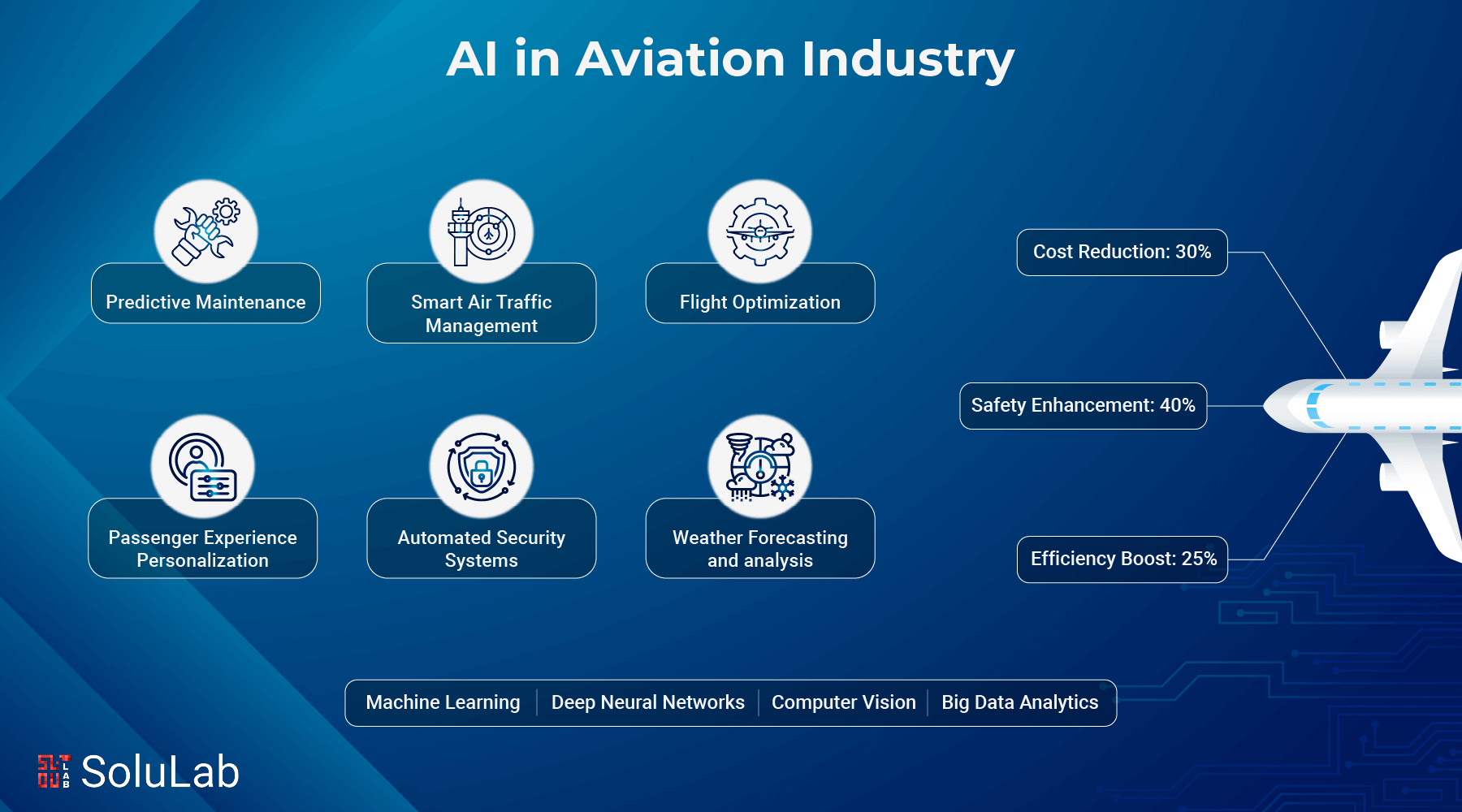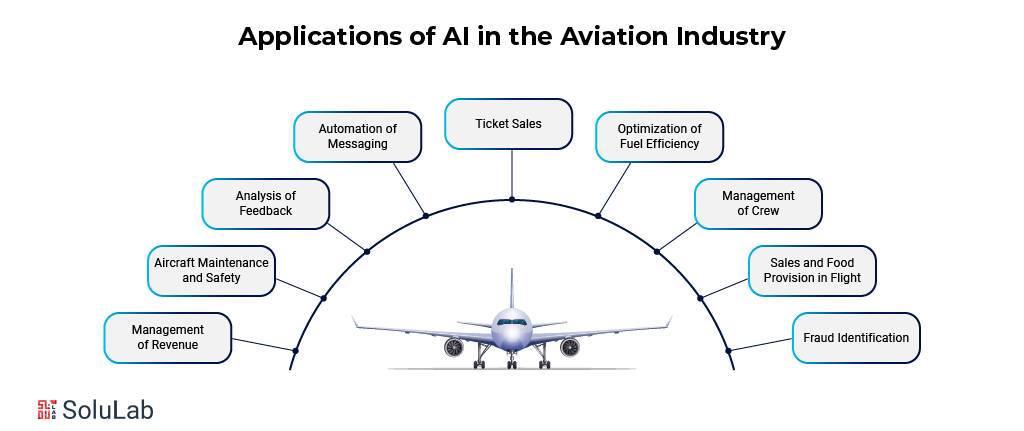
Do you know significant technological advancements are occurring in the aviation sector, largely as a result of artificial intelligence integration? AI is currently included in many airline sector solutions, ranging from customer service to crew management, maintenance, and flight planning.
Its commercial expansion amply shows its growing adoption. The market for artificial intelligence in aviation is expected to grow from its 2022 valuation of USD 728.05 million to USD 23 billion by 2031.
AI services in the aviation sector go beyond present operations as they continue to gain traction. In this article, we will explore breakthroughs and trends, use cases, and challenges in the field of artificial intelligence.
What Are Different Ways That AI Can Be Used in Aviation?
AI has several applications in aviation, such as in aviation education programs for air traffic control, flight optimization, predictive maintenance, Generative AI for customer service, and more, such as:
1. Predictive Upkeep
AI systems examine sensor data from airplanes to anticipate any malfunctions before they happen. By making sure that every element works properly, this proactive approach lowers downtime, prolongs the life of aircraft components, and increases overall safety.
2. Optimization of Flight
AI flight routes for shorter trip times and more fuel economy. AI can recommend the most cost-effective routes by considering weather, air traffic, and other factors, saving airlines money and reducing their carbon footprint.
3. Management of Air Traffic
AI improves air traffic control by supporting decision-making and real-time data processing. AI systems can anticipate possible airspace conflicts, recommend alternate routes, and enhance aircraft coordination, all of which contribute to safer and more effective air travel.
4. Client Support
AI-powered chatbots and virtual assistants enable airlines to offer prompt and effective customer support. By answering questions about flight status, luggage monitoring, and ticket reservations, these AI solutions free up human employees to work on more difficult problems.
The Main Applications of AI in the Aviation Industry

Let’s examine the various uses of AI in aviation in Customer Service Automation, illustrating its effects using actual cases.
1. Management of Revenue
To increase overall revenue, AI algorithms evaluate data, forecast demand, and modify ticket prices. This algorithm determines the best seat pricing based on weather, season, and day by taking into account past data, booking trends, and consumer preferences. To set fares, Delta Airlines uses revenue management technologies driven by artificial intelligence.
Glen Hauenstein, president of Delta, highlights how AI influences consumers’ willingness to pay for high-end goods, outlining a cooperative process in which analysts hone recommendations and machines make action suggestions.
2. Aircraft Maintenance and Safety
Unplanned maintenance, which caused over 7% of aircraft delays in 2023, is being addressed by artificial intelligence. Through data analysis from a variety of sources, including weather inputs, flight data recorders, and aircraft sensors, the aviation sector may improve air safety by utilizing AI capabilities. This raises overall safety standards by assisting in the identification of possible safety issues.
Airlines can detect defects, arrange repairs before they become critical, and track airplane components in real-time with AI-powered predictive maintenance solutions. Being proactive lowers maintenance costs decreases downtime, and boosts operational effectiveness. The AI system “Predix” from General Electric is a practical illustration of this. Predix greatly improves diagnostic capabilities by enabling GE Aviation Fleet Support to process a larger volume of engine data more quickly and precisely.
3. Analysis of Feedback
Airlines rely heavily on customer feedback, and artificial intelligence is now able to assist the business in better interpreting it. To identify patterns, sentiments, and reoccurring themes, for instance, AI-driven sentiment analysis tools, such as PureStrategy leveraging Automated Neural Intelligence Engine (ANIE), can be used to sort through a variety of feedback channels, including social media, blog posts, comments, customer review websites, and surveys.
Airlines can obtain important insights into client experiences through this proactive approach, which enables them to swiftly resolve problems and continuously improve their offerings.
4. Automation of Messaging
Customer service in the aviation sector is being enhanced by the use of messaging automation. It is being used by airlines to expedite their operations and provide prompt answers to inquiries. To save time and stay informed, passengers now automatically receive updates regarding flight timings, gate changes, and other crucial information.
A smart place to start with messaging automation is with AI-powered solutions, such as chatbots. AI chatbots are skilled at handling a variety of questions, including real-time flight updates, baggage issues, and travel reservations. The 2017 launch of KLM Royal Dutch Airlines’ “BlueBot” serves as a practical illustration of this. To date, this AI-powered chatbot has helped users with buying flights, managing reservations, and finding travel information.
5. Management of the Crew
AI in crew scheduling translates into more dependable and effective flights for airline 5. passengers. AI assists airlines in making sure that each aircraft has the appropriate crew members with the necessary training and expertise. This improves safety, cuts down on delays, and makes traveling more enjoyable overall.
Recently, Malaysia Airlines Berhad (MAB) signed a five-year agreement to switch to IBS Software’s iFlight Crew for its crew management systems. Their website claims that iFlight Crew is a cloud platform that uses AI and machine learning to optimize airline operations and crew management.
6. Optimization of Fuel Efficiency
Given the significant influence that fuel prices have on overall expenditures, artificial intelligence (AI) is essential to increasing fuel economy in the aviation sector. AI algorithms maximize fuel economy by evaluating variables such as weather, flight paths, aircraft performance, and passenger load. For instance, AirAsia employs OptiClimb, a fuel-efficient method. This program predicts fuel use using sophisticated weather forecasts and machine learning techniques. To save up to 3% of fuel per flight, it recommends the best ascent speeds during takeoff.
7. Ticket Sales
AI-powered recommendation engines in ticketing provide travelers with a more customized booking experience. Finding flights that meet your needs is made simpler by these technologies, which recommend tickets based on your past travel preferences, budget, and selections. This technology the booking process in addition to helping identify better bargains.
The partnership between Elemental Cognition and Oneworld Alliance, which created an AI tool for organizing and purchasing “Round the World” (RTW) tickets, is a prime example. Travelers can plan complicated vacations with many destinations on Oneworld Alliance member airlines more easily and effectively with this tool.
8. Sales and Food Provision in Flight
Thanks to creative algorithms that forecast demand, airlines may also utilize AI to customize in-flight meals according to passengers’ dietary needs and tastes. AI can also be used to cut down on waste in catering.
Food Scanner is a program that Airbus is creating. This AI-powered equipment has a barcode scanner and a camera that faces downward. It keeps track of and oversees in-flight food, recording the contents of meal trays and keeping an eye on the supply of beverages both before and after service. via generating key performance indicators from the data processed via a dashboard stored in the cloud, passengers may order meals in advance and have correct catering planning, which ultimately reduces waste.
9. Fraud Identification
AI is essential for detecting airline fraud since it reduces the risks connected to fraudulent activity. AI algorithms quickly identify suspicious trends and draw attention to possible fraud by examining large amounts of transaction data. An excellent illustration is the Airlines Reporting Corporation’s (ARC) Risk Check, which uses artificial intelligence (AI) algorithms to examine more than 3 billion data points and find cases of fraudulent travel bookings.
Read Also: Top 10 AI Development Companies in 2025
Use Cases of AI in the Aviation Industry
The industry may proceed with testing more sophisticated generative AI systems while maintaining a focus on safety, data integrity, and security. Let’s discuss AI use cases in the aviation industry:
- Customize Pilot Training: By adapting training situations to each pilot’s performance, generative AI can raise the realism of existing training simulators to a new level.
- Optimize Flight Routes and Timetables: The system can also combine information from weather patterns, air traffic, and past and current flights to determine the most fuel- and time-efficient routes and schedules, reducing delays and fuel usage.
- Encourage Predictive Maintenance: By analyzing sensor and other data and comparing it to historical data, generative AI can forecast possible faults and improve maintenance plans.
- Make Digital Twins: Virtual models of systems or products are commonly produced by MRO firms and aircraft designers. Without having to create physical models, they can test designs and improve performance more rapidly thanks to these digital twins. Digital twins can be created far more quickly with generative AI than with existing techniques.
- Airport Planning and Optimization: Designers and planners can model and improve aircraft ground traffic and passenger movement, as well as construct infrastructure and amenities, using intricate digital twins of new or existing airports.
Can Artificial Intelligence Fly a Plane?
Artificial intelligence is being used more and more to help with different parts of flying, even if it hasn’t yet advanced to the point where it can fly an airplane entirely without human assistance. Numerous commonplace tasks, like monitoring systems, modifying aircraft routes, and interacting with air traffic control, can be performed by AI systems. Full AI-operated flights are still at the experimental stage and rare in commercial aviation, however, some autonomous flight technologies have been developed. Human pilots are still necessary for making decisions in difficult or urgent circumstances.
The Future of AI in Aviation

Even while AI won’t be taking the place of pilots anytime soon, it will be crucial to the aviation sector’s future. Important elements consist of:
1. Forecasted Prices
Predictive pricing driven by AI is becoming more and more popular. Airlines can provide each passenger with a customized travel experience and competitive pricing by using AI algorithms to analyze vast amounts of data, including personal preferences and current market trends. This technology is already being used by Atlantic and Fetcherr to optimize operations and revenue by adjusting prices based on anticipated market variables. To optimize their revenue systems, more airlines are likely to adopt this “generative pricing engine.”
2. Eco-Friendly Air Travel
2% of the CO2 emissions linked to energy worldwide come from aviation. However, artificial intelligence will enable the International Air Transport Association to achieve its goal of net-zero emissions by 2050. Airlines can make informed judgments about operations, fuel consumption, and aircraft itineraries by utilizing machine learning and advanced analytics. By reducing carbon emissions, this data-driven strategy supports sustainability objectives and accelerates the sector’s transition to a more environmentally friendly future.
3. Improved Systems for Aircraft Health
AI-powered smart airplane health systems will grow in popularity. By analyzing data from the aircraft’s onboard sensors, these systems can identify possible problems early on and perform preventive maintenance. AI in health care reduced unscheduled maintenance, less aircraft downtime, and more safety are all benefits of this predictive strategy. Deloitte claims that this kind of predictive maintenance might reduce airplane operating expenses by up to 25% and avoid disruptions that could result in fatalities.
4. Better Flight Paths
Fuel makes up 22% of airline operating costs, making it the second-largest expense, according to Investopedia. Route planning that is impacted by air traffic and weather variations is to blame for this enormous expenditure on aviation fuel. Airlines will use AI tools and platforms more and more in the upcoming months and years to alter this perception.
These platforms analyze enormous volumes of data, such as weather patterns, air traffic, and previous flight data, and use projections and historical data to deliver fast insights. The outcome? routes that are optimized to save delays and conserve fuel. AI-powered route planning constantly adjusts in real-time to increase efficiency and reduce total flight time.
As is evident, there is a lot of potential for artificial intelligence in the airline sector. AI applications are expected to drive further revolutionary developments in this business as technology develops.
Challenges and Risks of AI in Aviation
While implementing AI in aviation has many advantages, there are drawbacks as well. Here are some of these dangers and difficulties.
- Technological Difficulties: There are technological difficulties that must be resolved when integrating AI into aviation systems. It can be challenging to make sure it functions properly with diverse hardware and software across different aircraft models and manufacturers.
- Moral Points to Remember: Determining the degree of autonomy for AI decision-making raises ethical issues that require careful thought, particularly in urgent circumstances.
- Workforce Challenges: The development, upkeep, and operation of AI require a highly qualified staff. Training aviation workers to close the skills gap is a significant undertaking. Concerns around job security may also arise from the move to AI. A transition depends on addressing these issues and providing retraining choices.
- Regulatory Obstacles: Introducing AI requires adhering to the stringent regulations of the aviation sector. It can be difficult to modify rules to address the novel issues raised by AI in the aviation sector.
Conclusion
AI has completely changed aviation, improving passenger experiences, increasing safety, and changing operations. It is safe to claim that artificial intelligence integration in aviation is now required rather than optional. But for a smooth adoption, picking the correct technical partner is crucial. Here is where Symphony Solutions shines.
In airline software development, advanced analytics, and machine learning are what your company needs to fully utilize artificial intelligence, whether your goal is to improve the customer experience, speed booking, sell tickets, or evaluate opinions.
SoluLab helped AI-Build, a construction tech company, use generative AI and machine learning for advanced product development in the CAD space. Their goal was to automate design processes, improve productivity, and enhance accuracy. The challenge was creating a system that could generate optimized designs while reducing manual tasks and ensuring scalability. SoluLab’s an AI development company expertise enabled AI integration, improving efficiency and performance. SoluLab has a team of experts ready to solve your business queries—contact us today!
FAQs
1. Can AI replace pilots in the future?
AI can automate many flight tasks, but human pilots remain essential for critical decision-making, emergencies, and passenger trust. While AI enhances safety and efficiency, full autonomy in commercial flights is unlikely soon due to regulatory, ethical, and technological challenges.
2. How does AI help with aircraft maintenance?
AI-powered predictive maintenance analyzes sensor data to detect potential issues before they cause failures. This proactive approach reduces unplanned downtime, lowers maintenance costs, and enhances aircraft safety by ensuring timely repairs and part replacements, improving overall operational efficiency.
3. What AI technologies are commonly used in aviation?
The aviation industry leverages machine learning for predictive analytics, computer vision for security and inspections, natural language processing (NLP) for customer support, and robotics for baggage handling and maintenance. These technologies optimize operations, enhance safety, and improve passenger experience.
4. Can AI help reduce flight delays?
Yes, AI processes real-time weather, air traffic, and operational data to predict potential delays. It optimizes flight routes, improves scheduling, and enhances decision-making, helping airlines minimize disruptions, reduce wait times, and improve overall efficiency in air travel.
5. How does AI improve aviation safety?
AI enhances safety by identifying mechanical issues before failures, assisting pilots in real-time decision-making, and strengthening security screening. It analyzes flight data to detect anomalies, prevents human errors, and ensures compliance with safety regulations, making air travel safer and more reliable.






